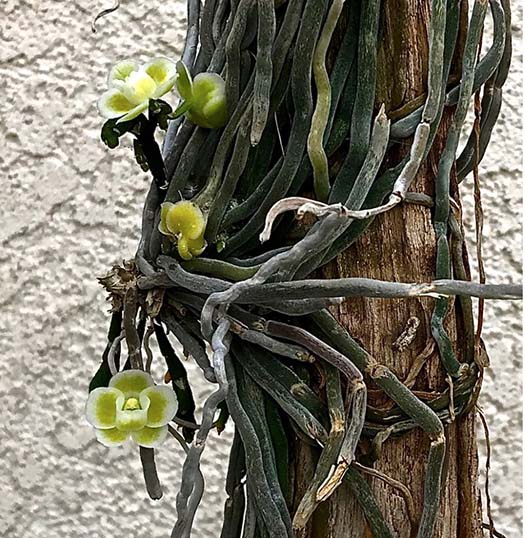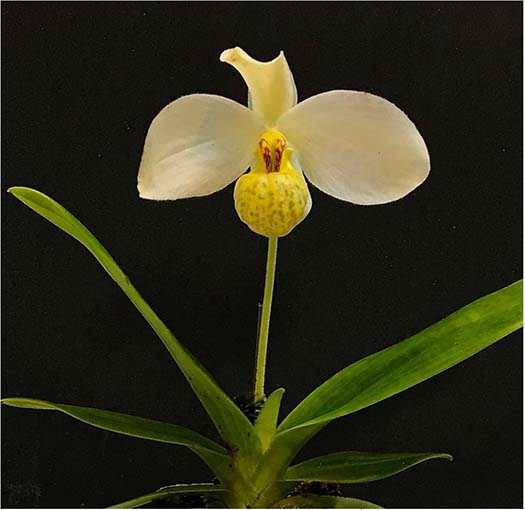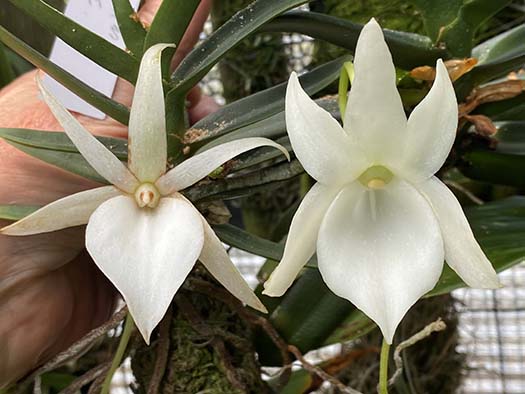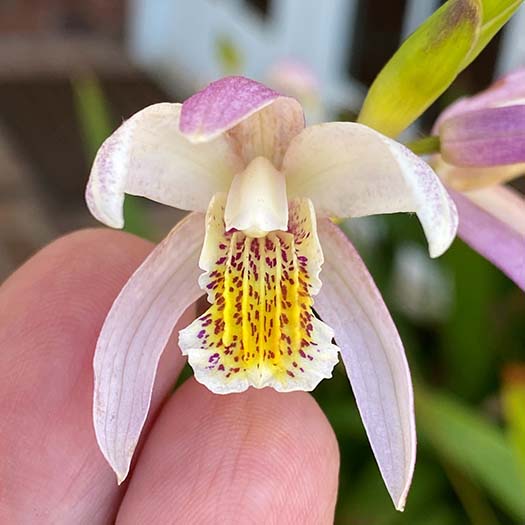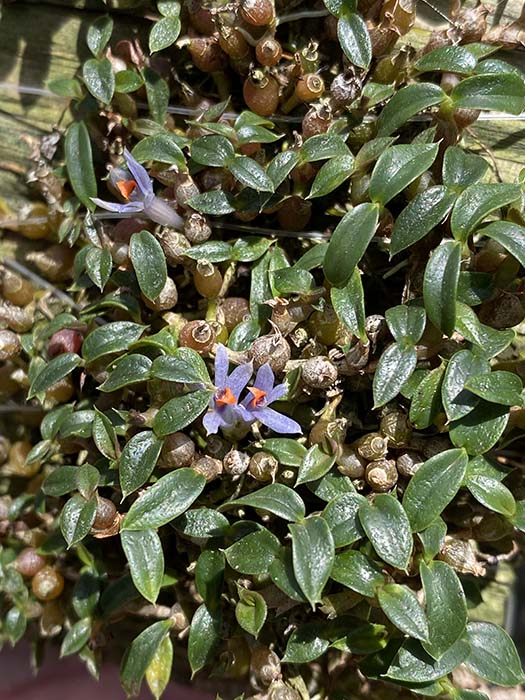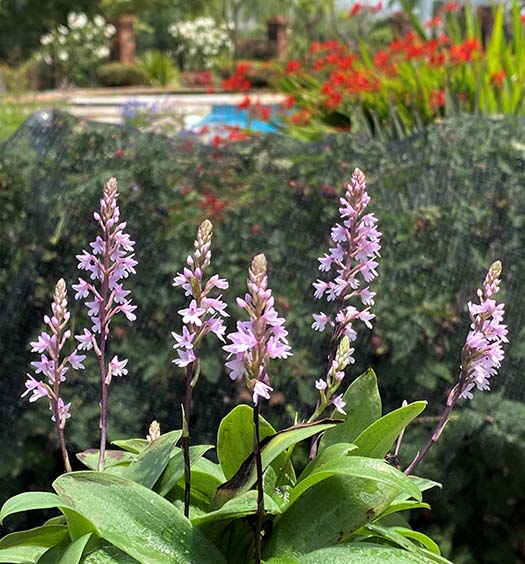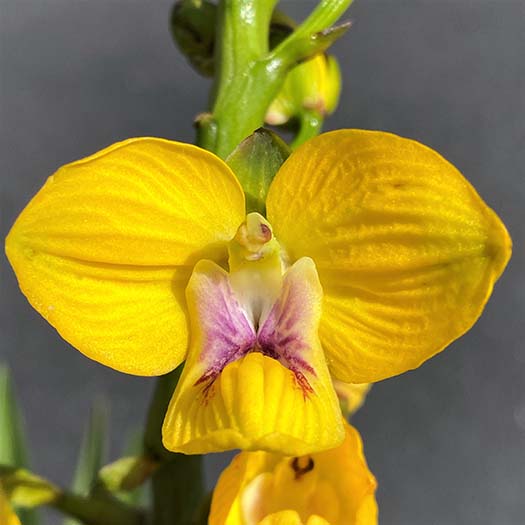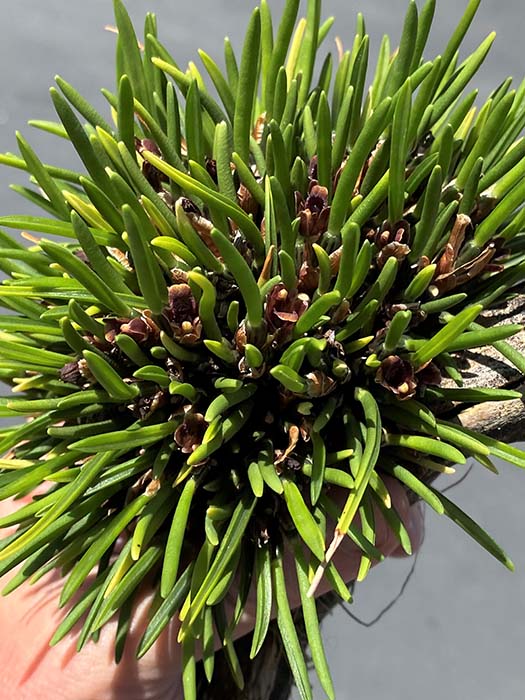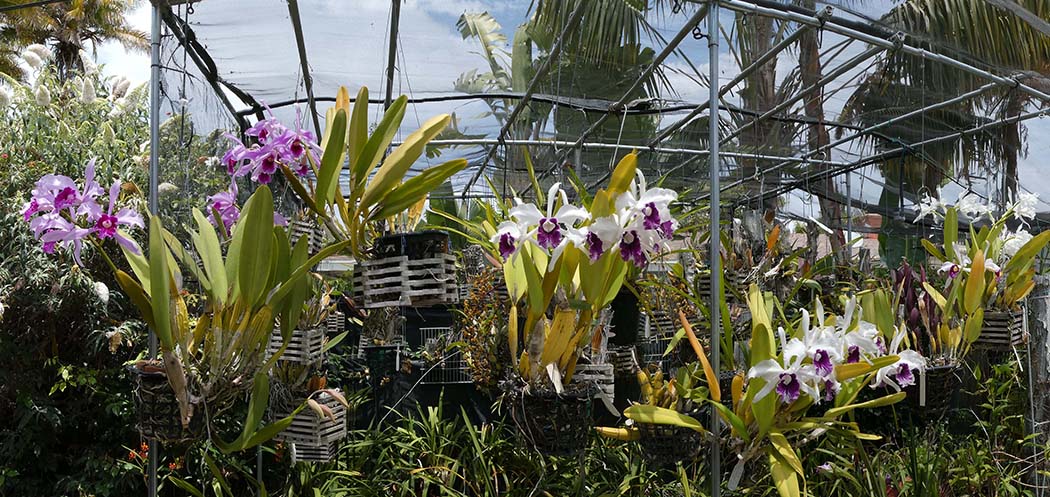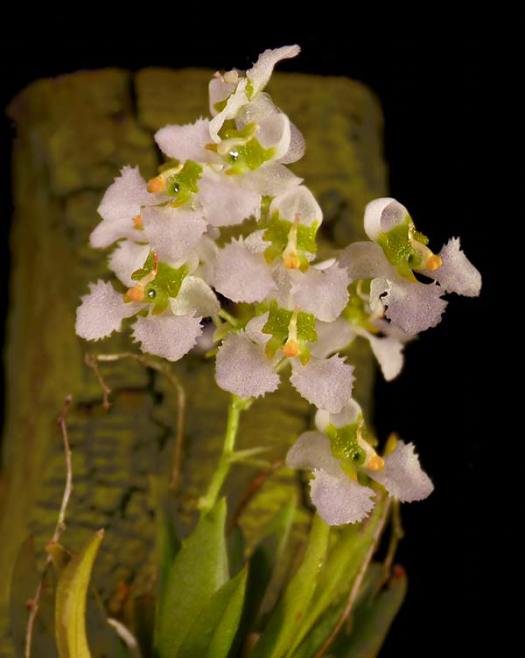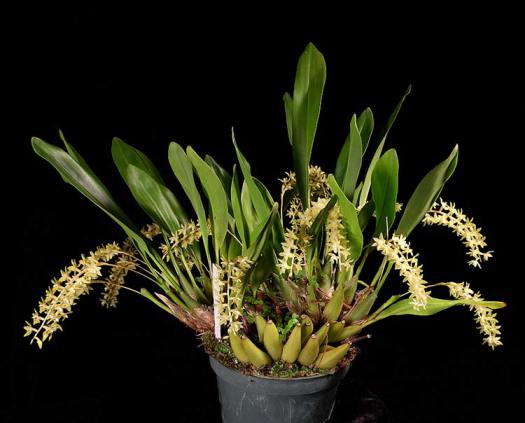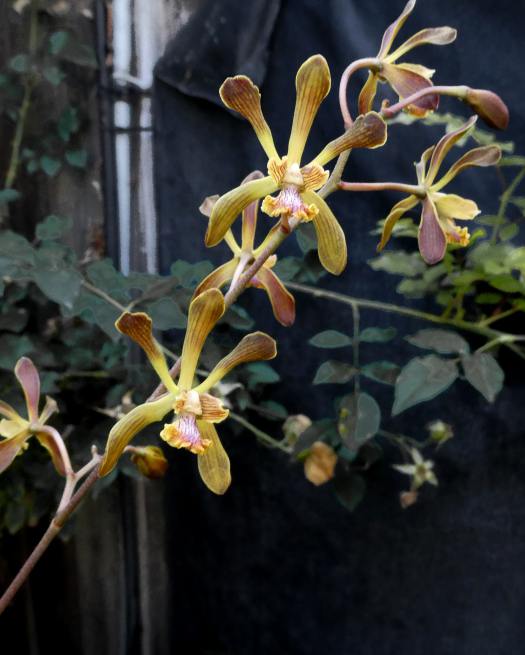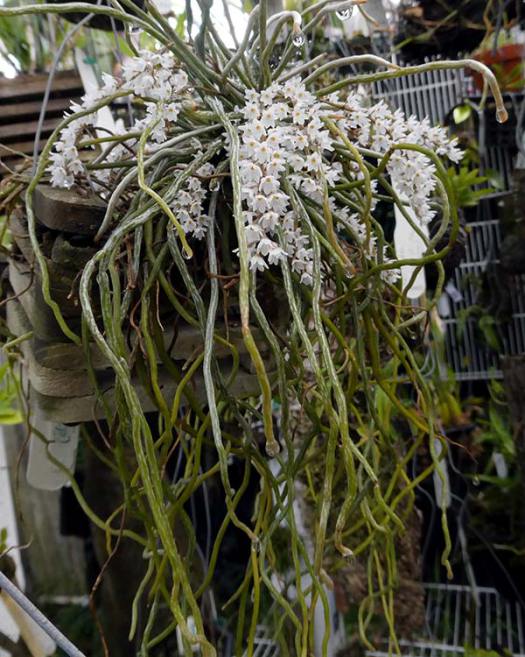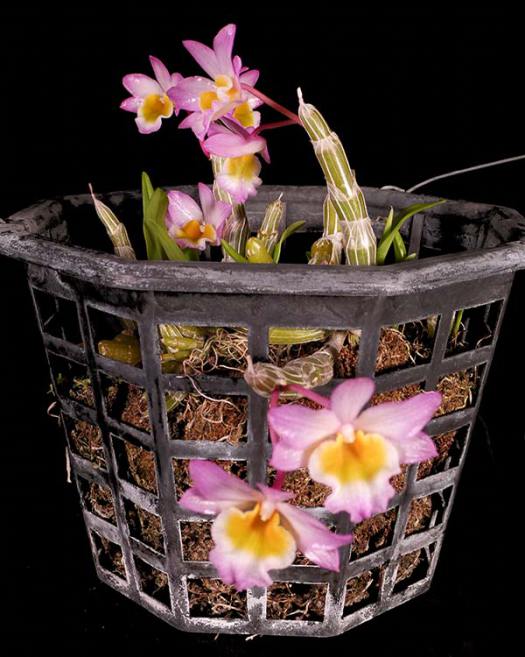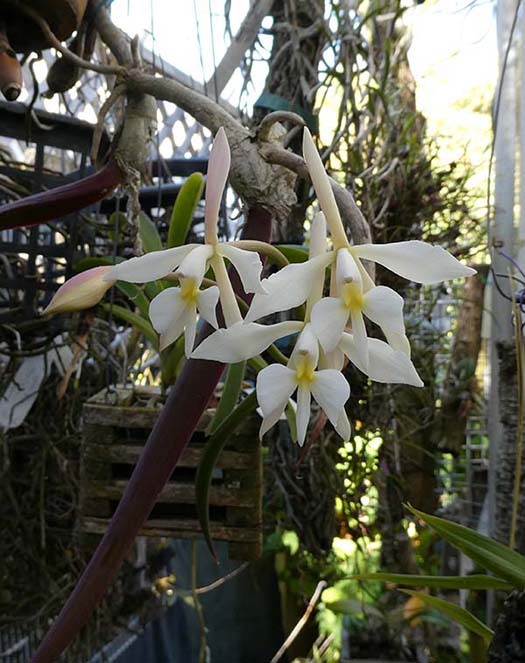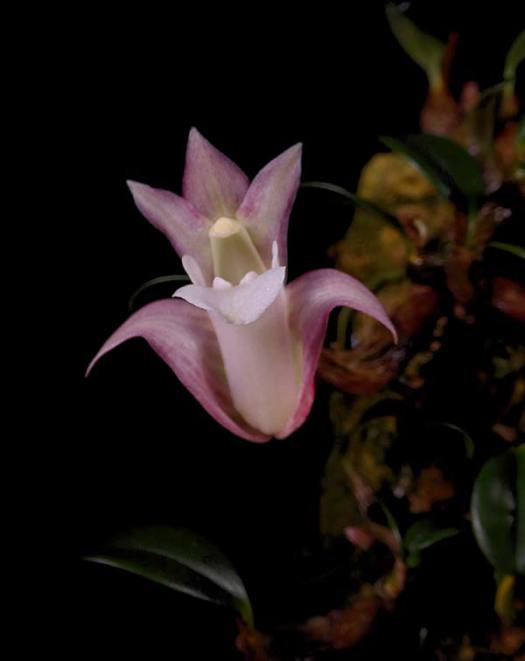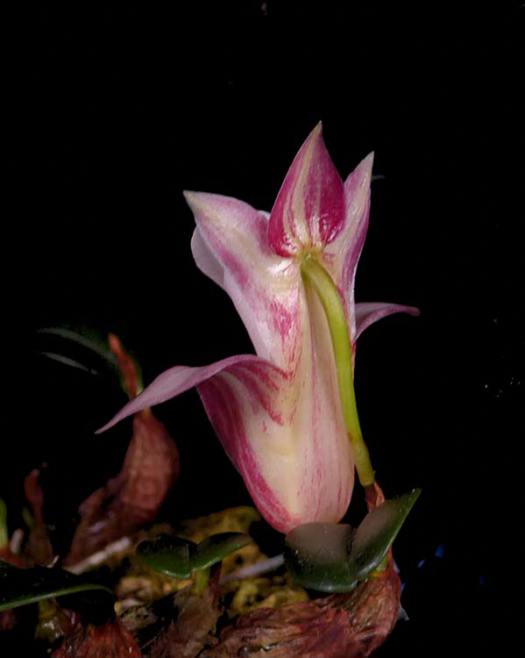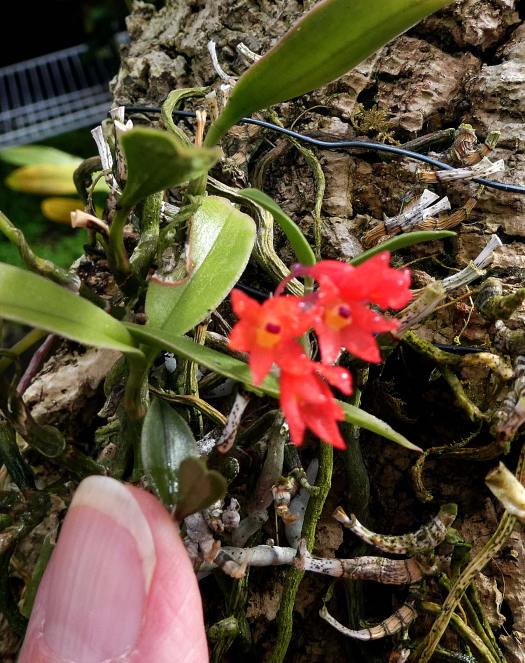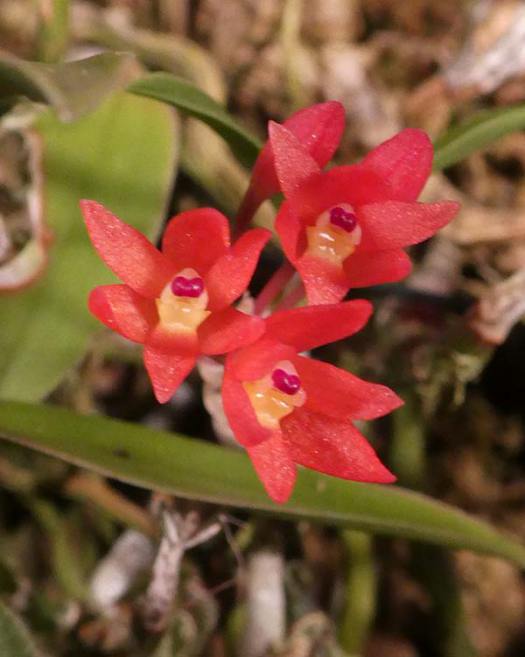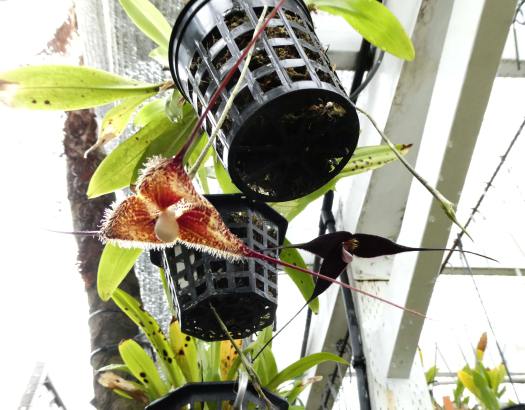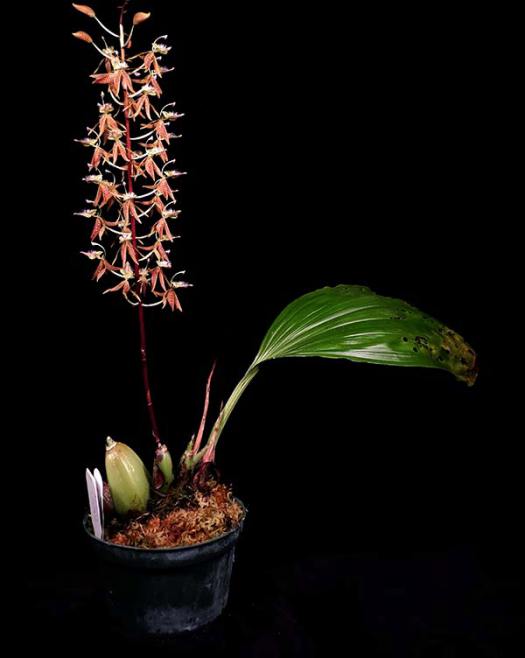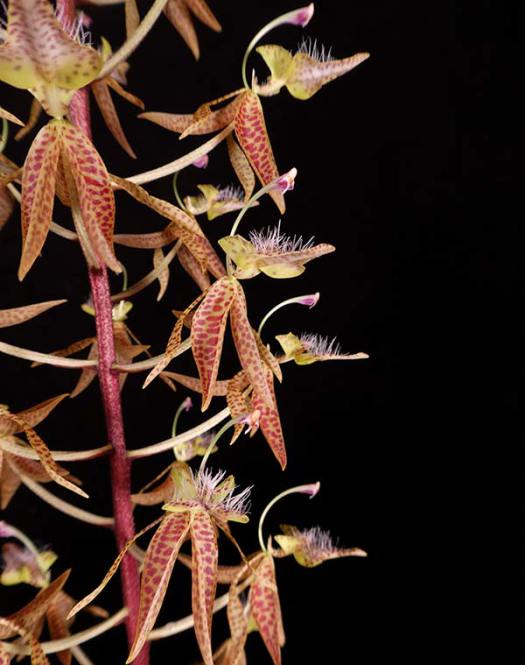July 2021
From Lynn Wiand:All orchids grown outdoors, coastal southern California |
|
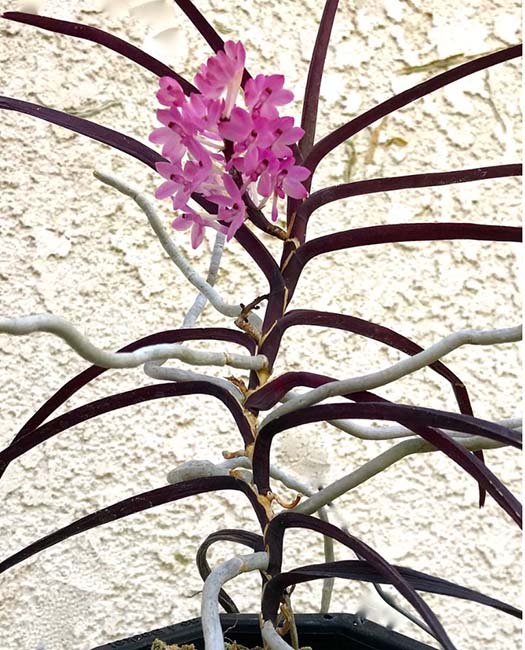
Ascocentrum christensonianum1/4" flowers |
|
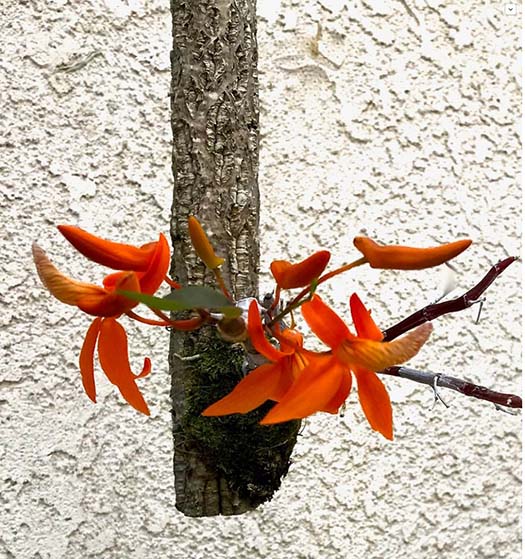
Dendrobium unicumFrom Thailand. 1.5" flowers. Deciduous |
|
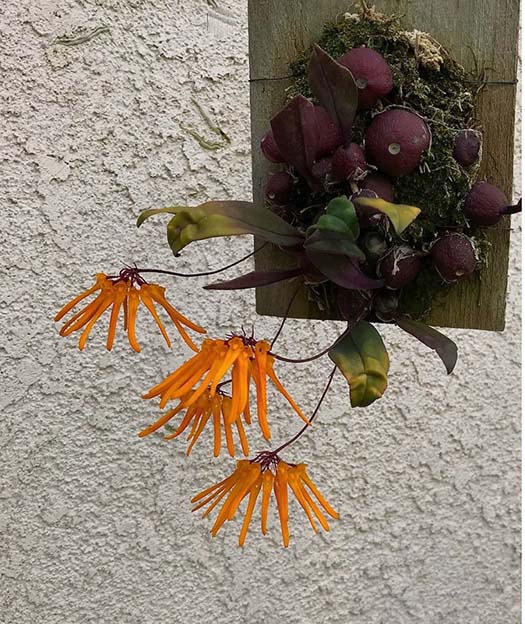 |
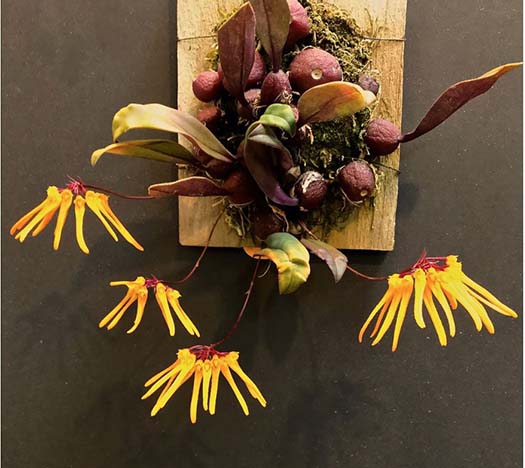
Bulbophyllum (Cirrhopetalum) thaiorumFrom Vietnam. Photo on the left was takin in natural light. The one on the right is under artificlal light. (White-balance adjustment is needed to compensate for the warmer spectrum of artificial light to get more accurate colors) |
From Scott McGregor:All orchids grown outdoors, coastal southern California |
|
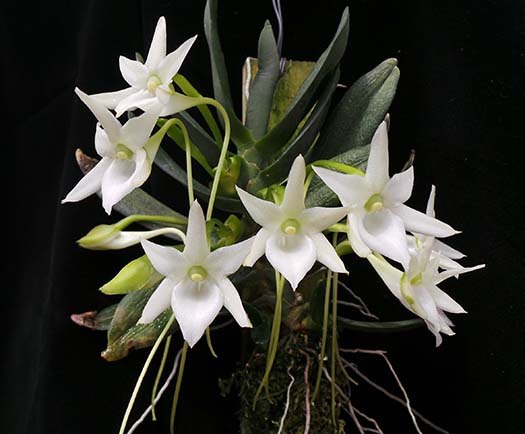 Angraecum compactum |
|
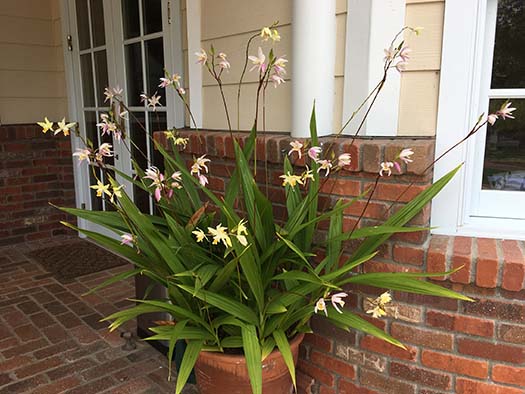 |
|
Bletilla ochraceaBletilla ochracea wins my vote as the easiest orchid to grow and flower well. The species has been line-bred, is widely available and inexpensive, and you can find yellow, pink and other color variations. It is briefly deciduous in the winter, likes a large pot, regular terrestrial mix and a few hours of full morning sun. Mine is a mix of yellow and pink in an 18” pot (for the last 10 years), blooming continuously from April through September. |
|
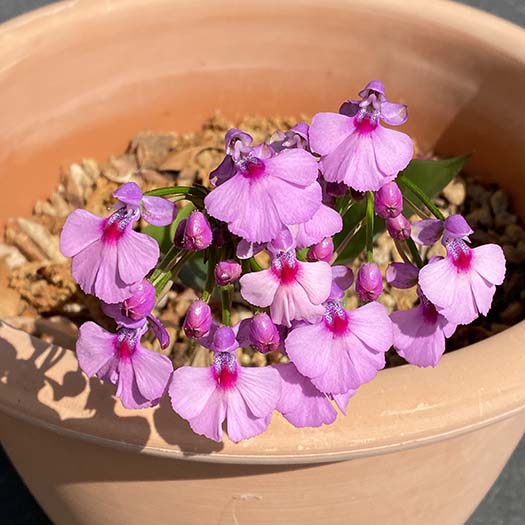
Cynorkis uncinataA pretty pot of 2” flowers opening up from this Madagascar terrestrial species. It is often listed as a “warm” grower, but I grow it in a 10” pot outside all year round-- a couple hours of full sun and lots of water/fertilizer as it emerges and blooms in the late Spring, and then dry as it goes dormant and dies back over the Winter. |
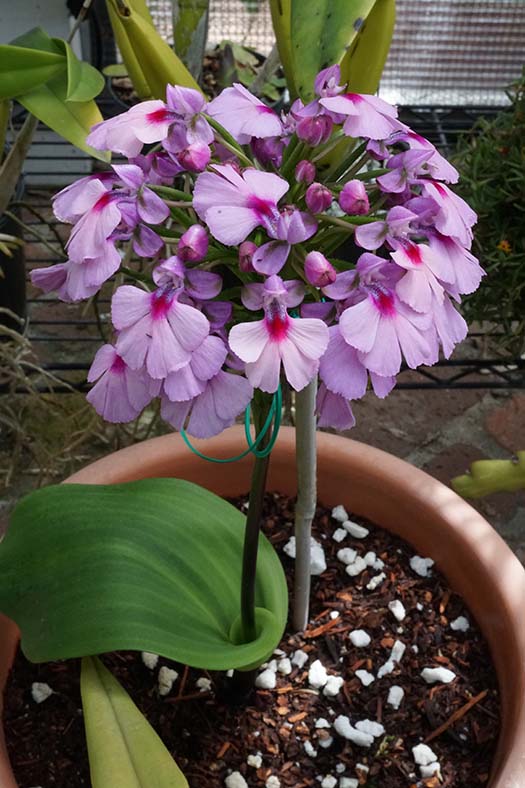 |
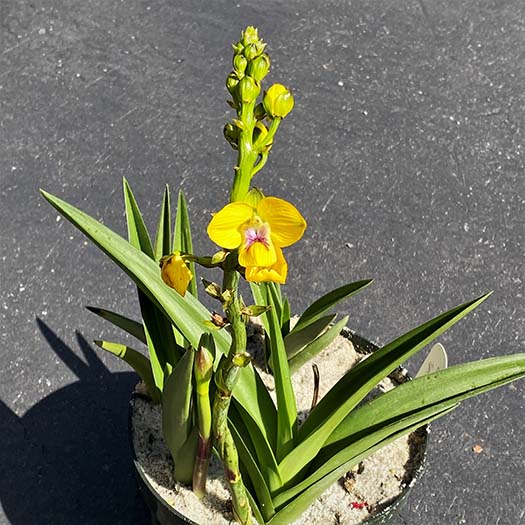 |
|
Eulophia speciosaI got this plant as a division from Roberta Fox a couple years ago. It is native to the arid regions of Africa including Yemen and Saudi Arabia, and seems to be quite happy potted in sand getting several hours of full sun (similar to E. petersii, only this one is much prettier). The 2-3” flowers open a few at a time sequentially over most of the summer. |
|
.jpg)
Maxillaria minutaYet another micro-mini from Brazil, with tiny, ugly dark red flowers tucked in between the terete leaves. I dare say this plant is actually much prettier when not in bloom! The flowers do have one redeeming feature though—they have a wonderful cinnamon-allspice fragrance. Perfect for people who love odd species. |
|
From Roberta Fox:
|
|
Outside in the Back Yard: |
|
Cattleya (Laelia) purpurata timeThey're putting on a grand show. From left to right... L. purpurata f. vinicolor, L. purpurata (f. lineata x f. flamea), L. purpurata f. schusteriana (2 of them) and L. lobata f. alba (close relative) Additional color forms continue to open - don't have room to show all. |
|
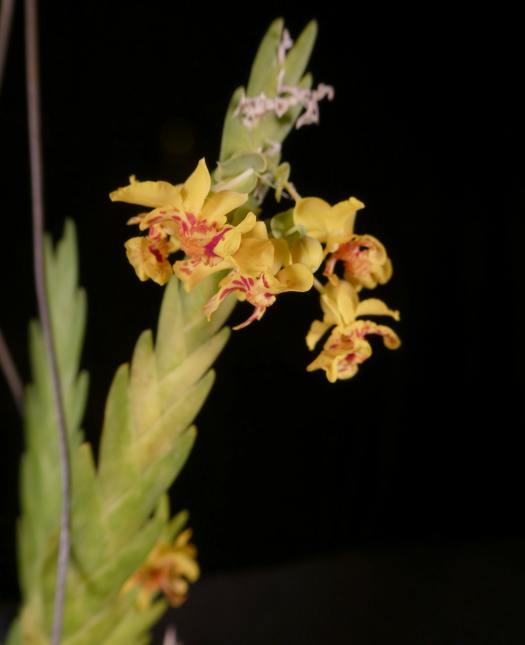
Lockhartia oerstediiFrom Mexico and much of Central America, elevations up to 2700 m. The "braided" growths bloom repeatedly. Old ones die back and new ones sprout. This is rather easy to propagate. I have it growing in a 4 inch basked with hardly any medium. I have tried it potted, but it is not nearly as successful that way. |
|
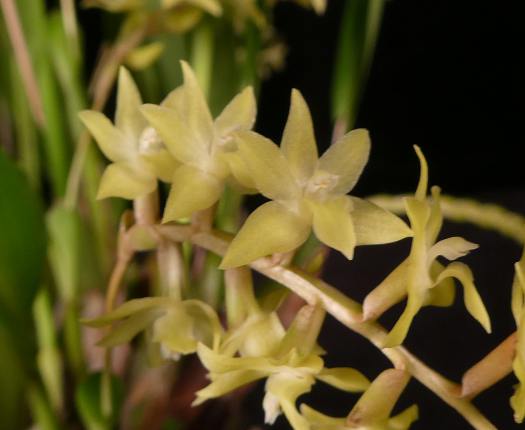 |
|
Dendrochilum pangasinanenseFrom the Philippines. Both Charles Baker and Jay Pfahl list it as a warm grower, but it does just fine on my patio. It started out as an SBOE $7.50 show special, but has grown up into a very nice-sized plant. Flowers are large for the genus, about 3/8 inch. |
|
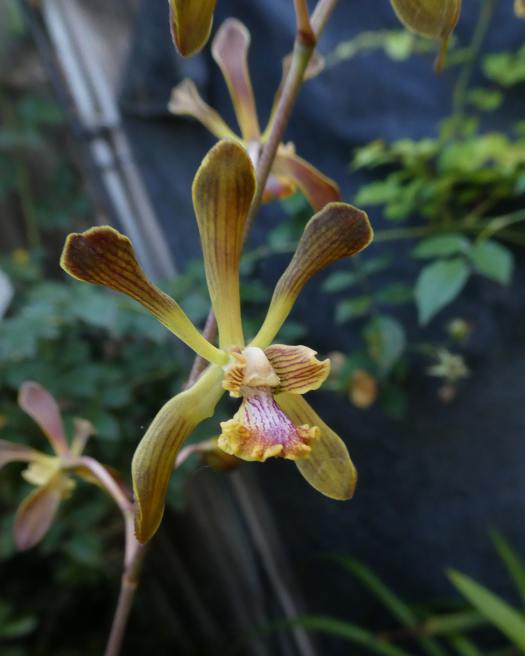 |
|
Encyclia belizensis ssp. parvifloraThis is an easy plant to grow and bloom, either mounted or potted. Kew has lumped it with E. alata, but that one is much darker and not nearly as vigorous. |
|
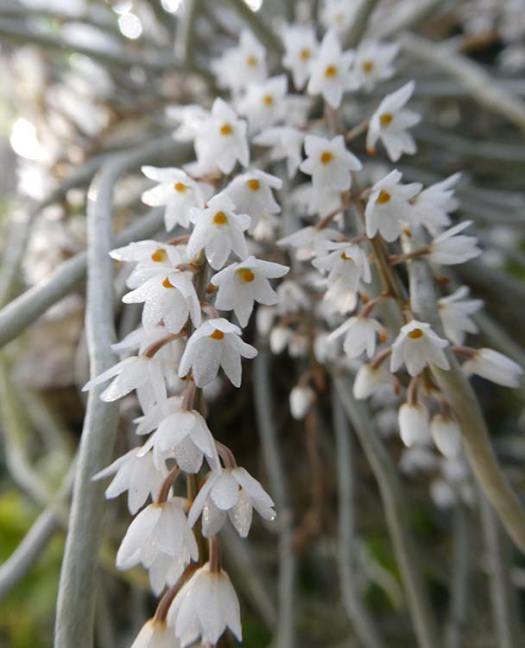 |
|
Microcoelia stolziiThis leafless Angraecoid is one of the cooler-growing members of the genus. It is native to much of central and eastern Africa. The prolific roots turn green when wet, and provide all the photosynthesis that it needs. It grows shady and damp. |
|
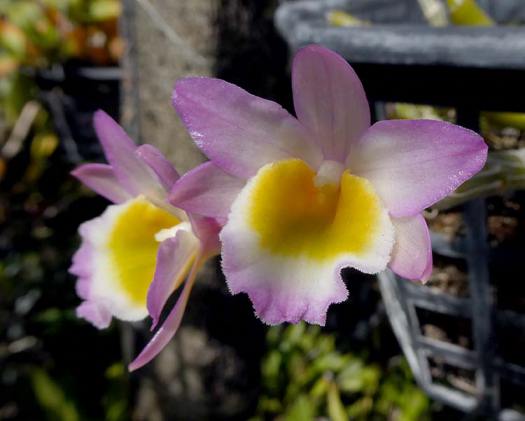 Dendrobium crepidatumNative to southeast Asia, the Himalayas, and southern China, aat elevations from 650 - 2100 m. It blooms on leafless canes, then produces new growth. I don't particularly dry it out, and it seems to grow and bloom just fine. |
|
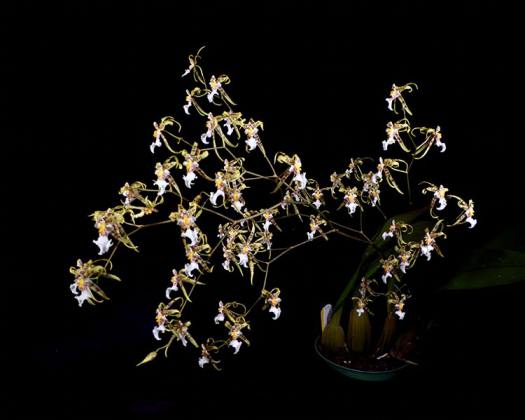 |
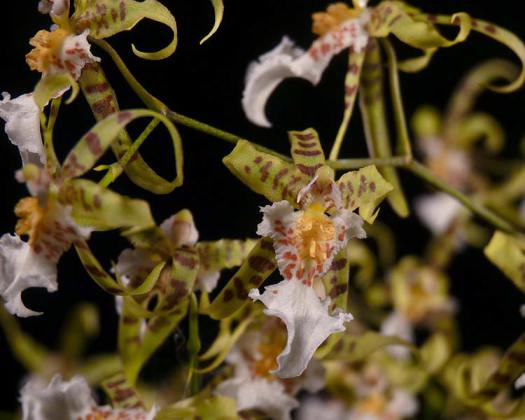 |
Oncidium phymatochilumNative to eastern Brazil at an elevation of around 1300 m. The inflorescence looks like a cloud of wispy flowers. |
|
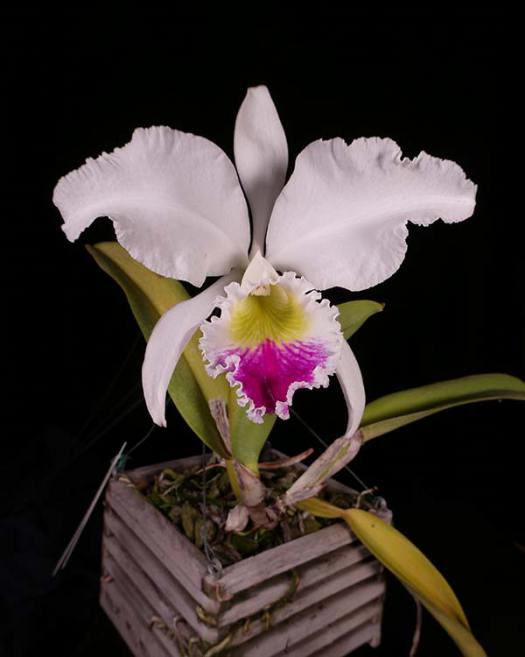
Cattleya warneri f. semi-albaFrom easthern Brazil, the elevation range of 100-200 m would indicate that this needed to grow warm. But it has been found up to 800 m. I have tried growing it in the greenhouse but it does better outside, as does the closely-related C. labiata. |
|
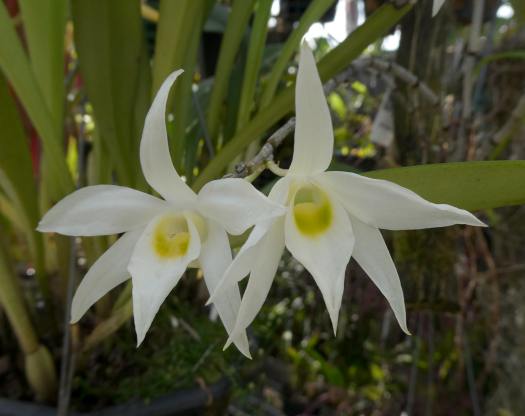
Dendrobium wilsoniiFragrant flowers emerge on bare canes. Like most of my Himalayan/SE Asian orchids, it gets watered during the winter and blooms anyway. (The leafy background is another plant) Flowers are quite fragrant. |
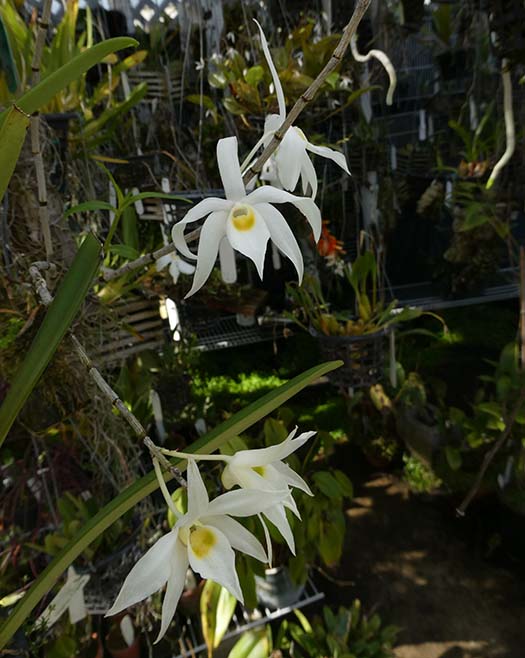 |
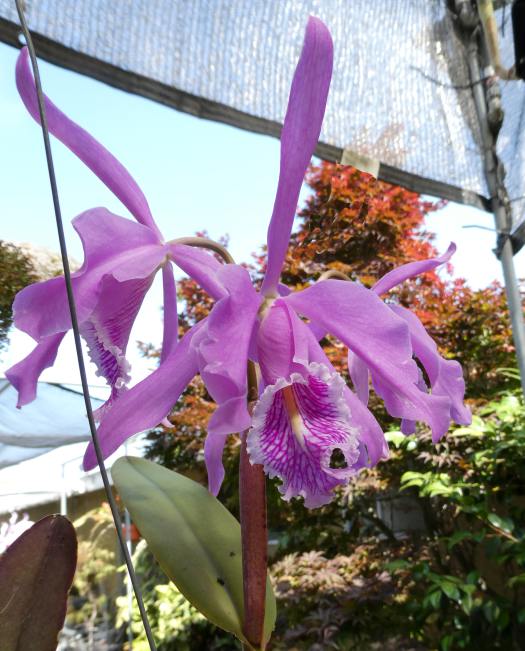 Cattleya maximaNative to Ecuador. This is the highland form, which is shorter and has darker flowers than the warm-growing lowland form. My Catt species seem to grow best in - and out of - wooden baskets. |
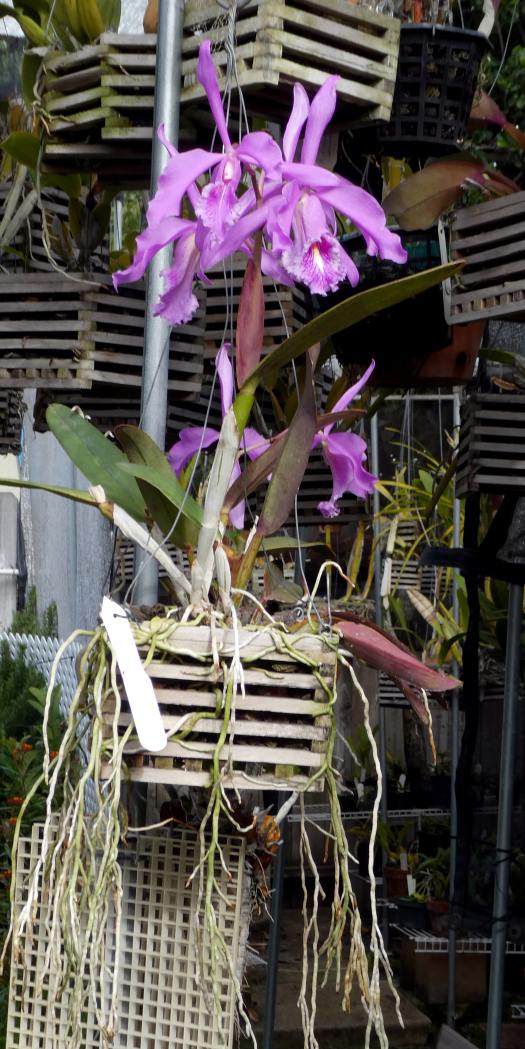 |
Epigeneium fargesiiFlowers are bigger than the leaves. The buds have a very attractive stripe pattern, which shows on the back of the open flower. The genus has been lumped into Dendrobium, but to me, they are quite different. |
|
Sobralia undatocarinataFrom Costa Rica and Panama. Like the rest of the genus, the flowers are short-lived but bloom sequentially. This is a realatively small plant, about 12-18 inches. |
.jpg)
Sobralia macrantha (possibly Sob. rogersiana)This was labeled Sobralia macrantha, but the flowers are larger and darker than my other Sob. macranthas. Sob. rogersiana has been established as a different, closely related species. It almost glows in the sunshine. |
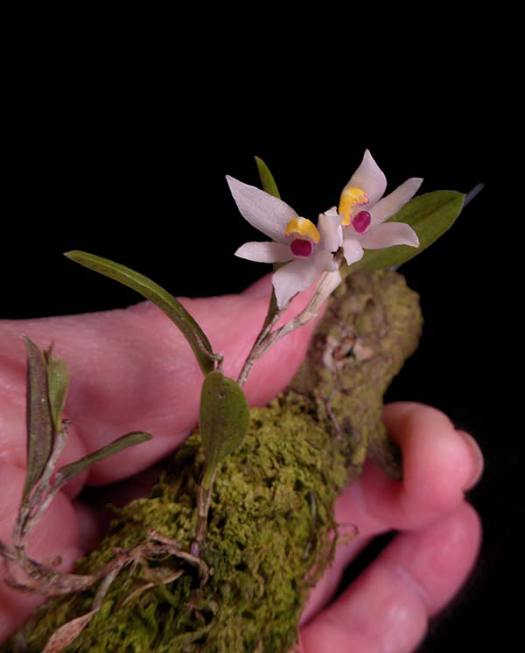 Loefgrenianthus blanche-amesiaeNative to Brazil, this Cattleya-tribe twig epiphyte has a name bigger than the plant. The flowers nod downward, so one needs to turn it upside down to appreciate the beautiful little flowers. |
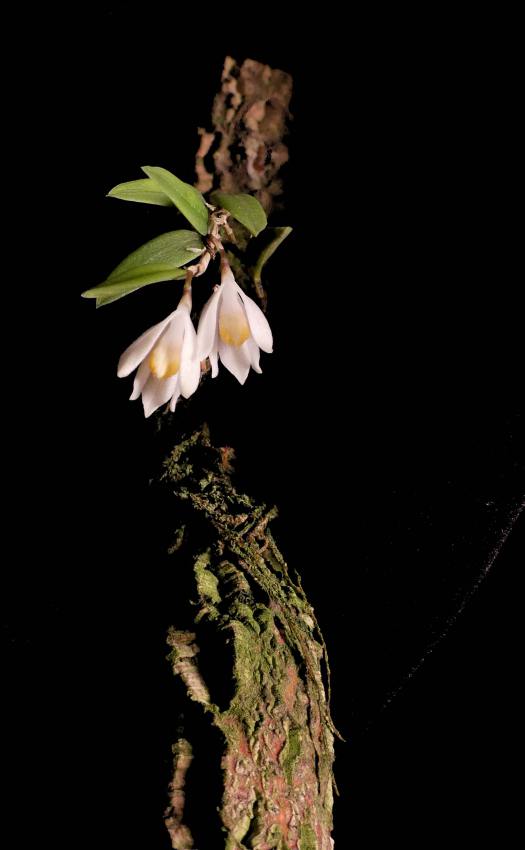 |
Alamania puniceaAnother miniature! (A solution to running out of room is to gravitate to small plants...) Flowers are about 1/4 -3/8 inch, but the brilliant color makes them stand out. The species comes from southern Mexico at elevations from 1500-2000 m. This is still a small division, I'm looking forward to seeing it get bigger with multiple inflorescences. |
|
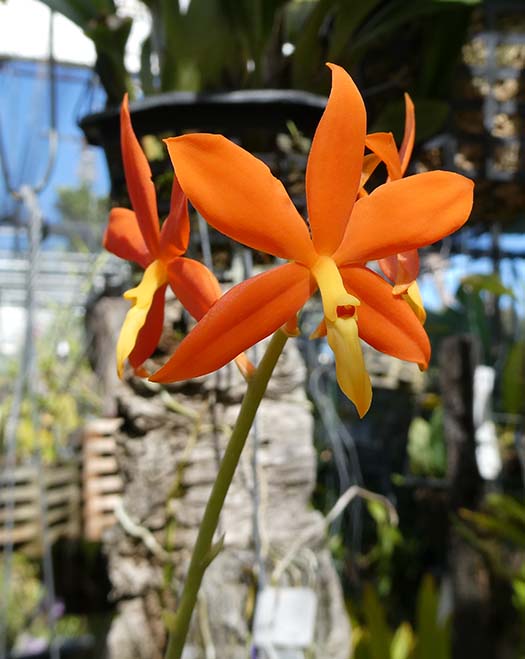
Encyclia vitellinaThe saturated color and long flower life are attractive features of this species from southern Mexico and Central America. The inflorescence will continue to produce flowers for several months. |
|
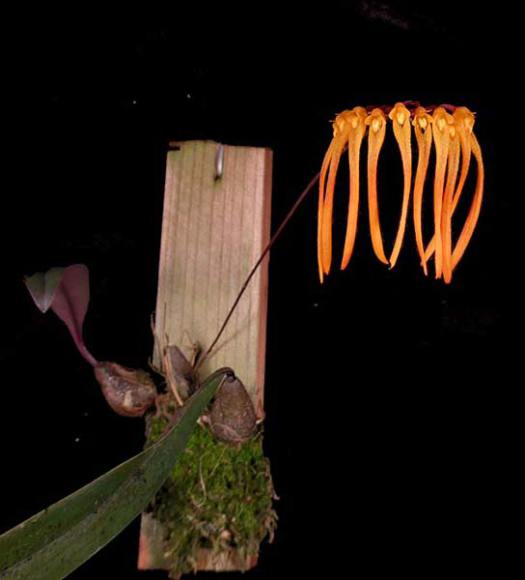
Bulbophyllum (Cirrhopetalum) thaiorumThis one is blooming for me for the first time. It grows on my patio, shady and damp. |
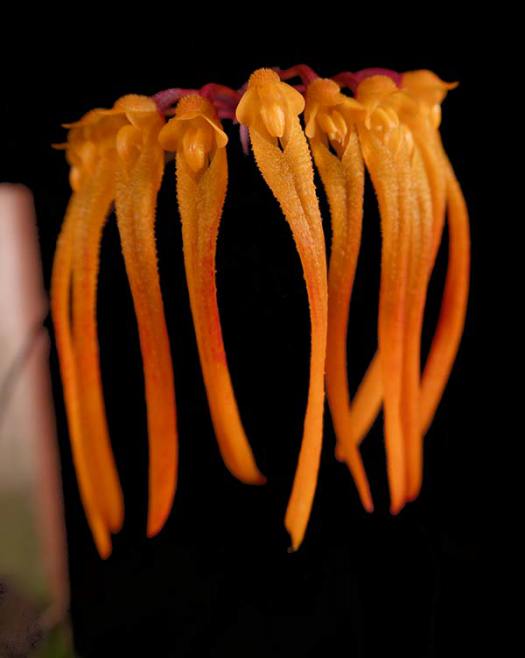 |
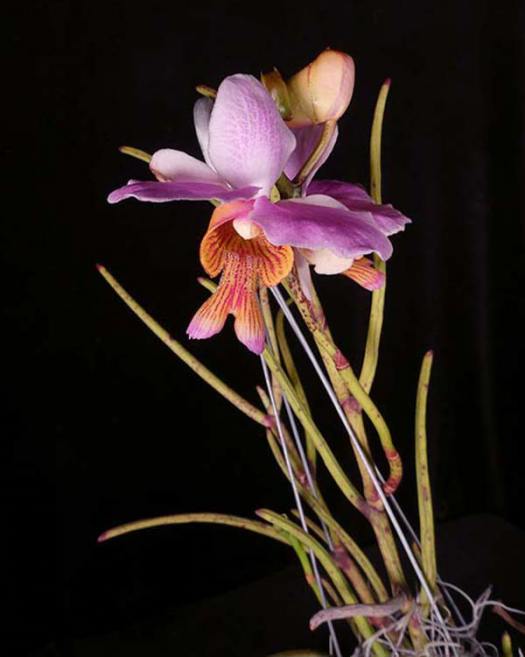 |
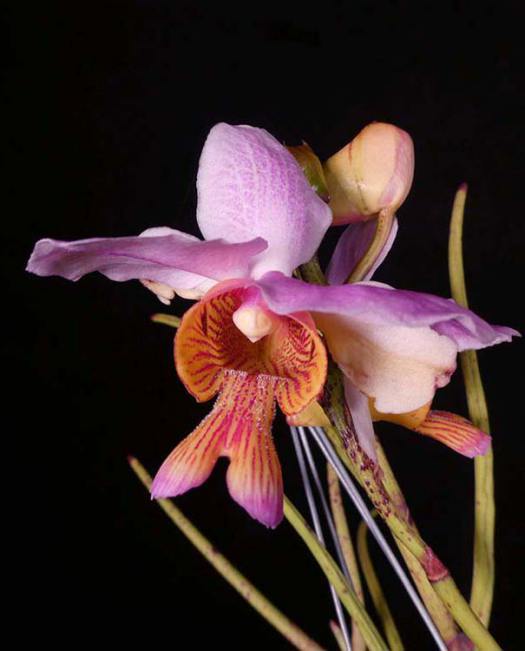 |
Papilionanthe teresThese previously were known as "terete Vandas" but now are in their own genus. I got this from Cheryl DiDonna before she moved to Hawaii. Thanks, Cheryl! I grow it in full sun in the area above the Cymbidiums. It is next to the Epi. lacustre plants, because it has similar needs - lots of sun, and also frequent watering. |
|
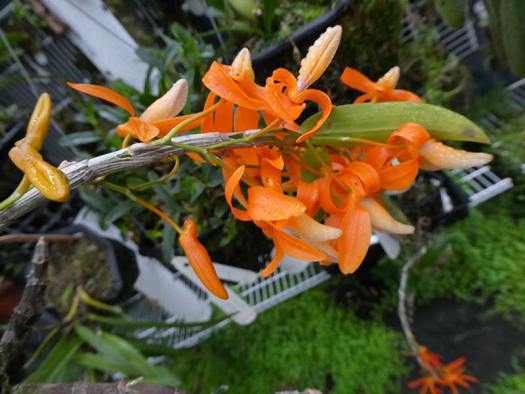
Dendrobium unicumCompare with Den. dickasonii that I showed last month, photo-bombing near the bottom of this picture. Larger flowers, a little lighter in color but still VERY orange. It blooms on nearly-bare canes just as new growth is starting. As with most of these deciduous Dendrobium, it gets watered in winter but being mounted, it dries very fast and that doesn't seem to be a problem. |
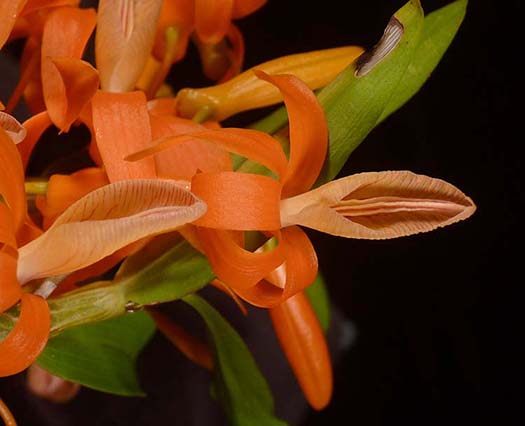 |
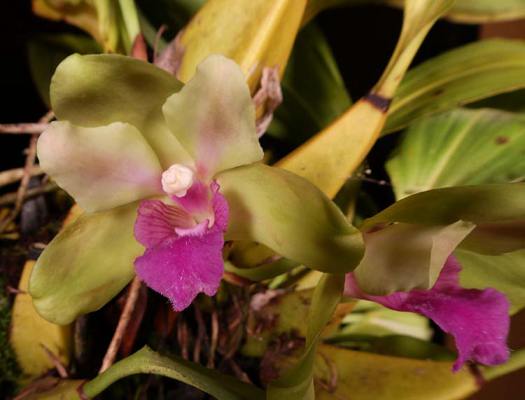 |
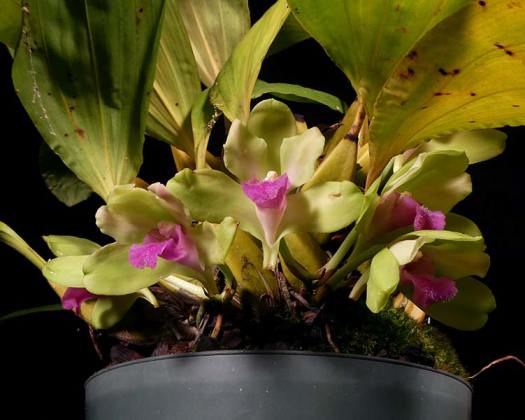 |
Bifrenaria inodoraFrom southern Brazil. In spite of the name, it actually is lightly fragrant when warm. Unlike some other Bifrenarias, it grows relatively shady. |
|
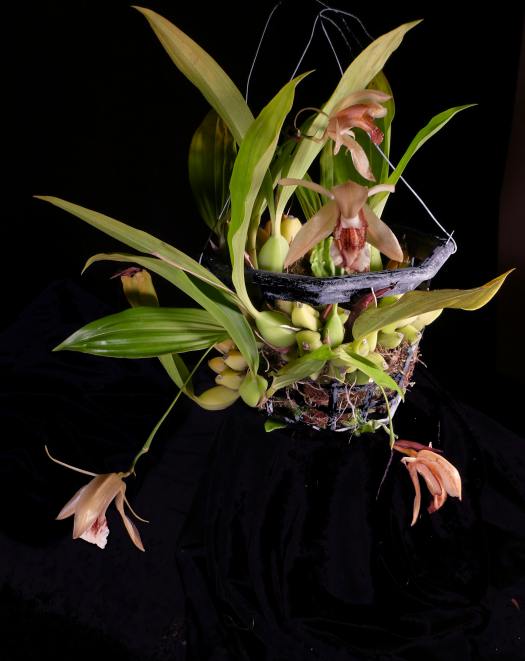 |
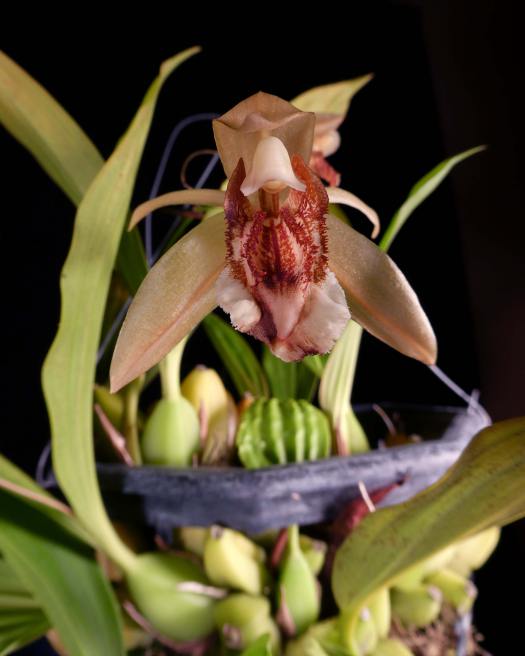 |
Coelogyne speciosaGrows on the shady side. It sulked for several years after repotting, and now seems to bloom and grow best where it escapes from the basket - I cut away part of the basket to let the growths go where they wanted. |
|
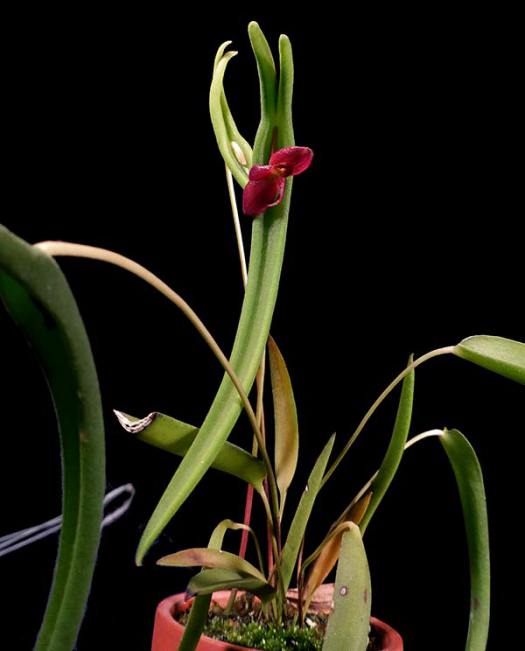 |
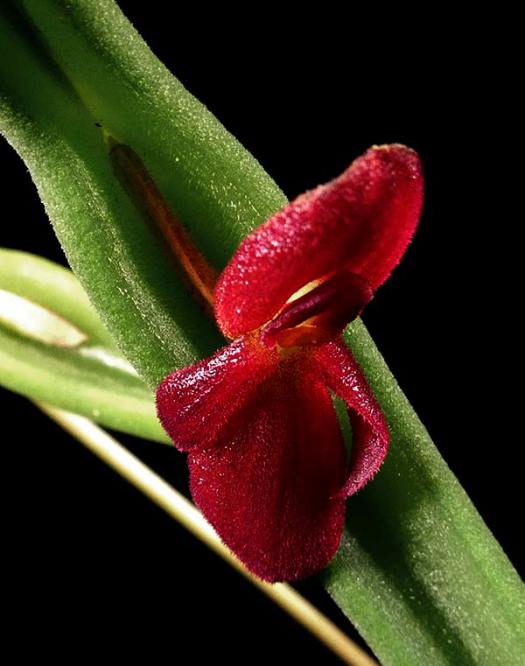 |
Pleurothalls dilemmaThe leaves look to me a bit like string beans. It blooms sequentially from the mature growths. I got this one at Scott's suggestion, and I am very fond of it.The contrast of the dark red flowers against the green leaves is quite dramatic. |
|
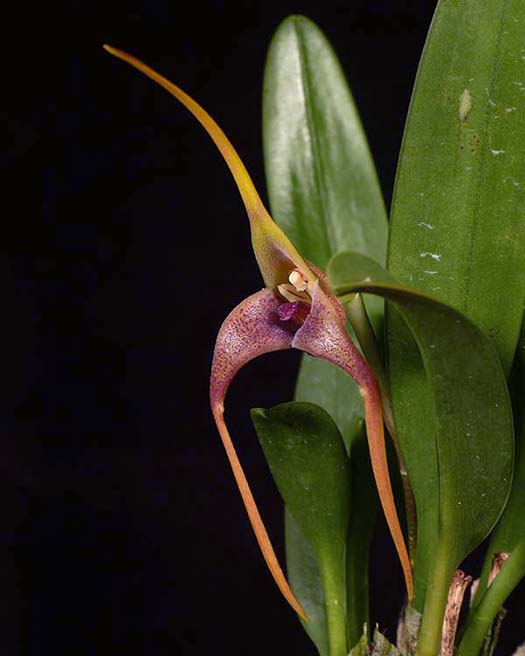 |
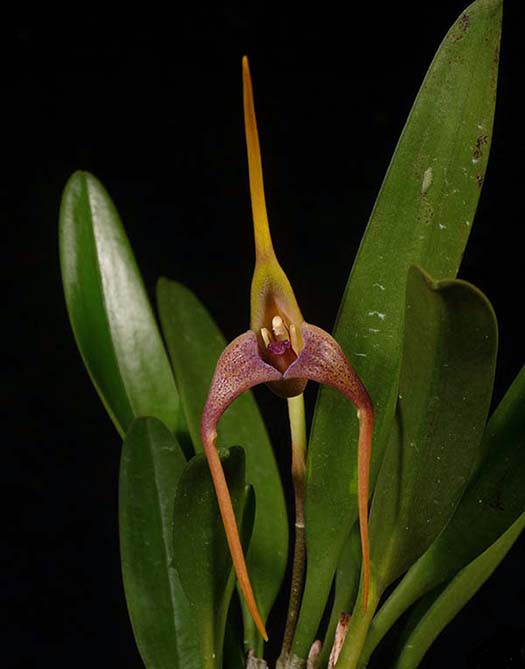 |
Masdevallia colossusThis flower lives up to its name relative to the plant. The plant is a bit over 6 inches tall, and the flower is about 5 inches. It also has heavy substance. |
|
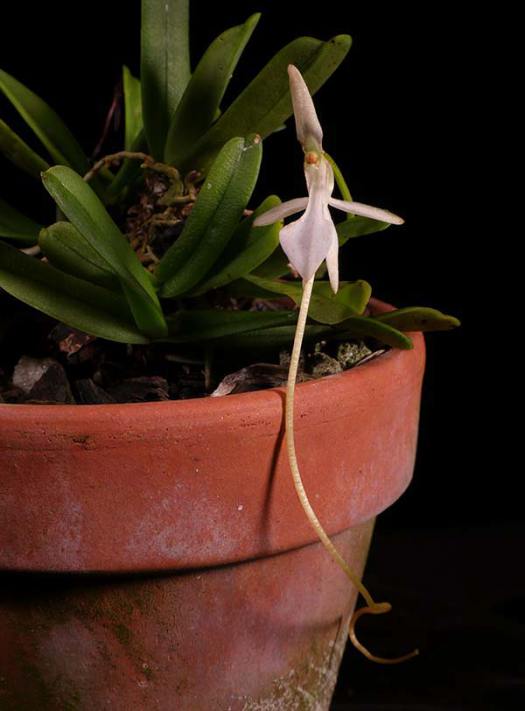
Jumellea densifoliataWhile most Jumelleas are rather topical, this one comes from the central highlands of Madagascar, and is very cold-tolerant |
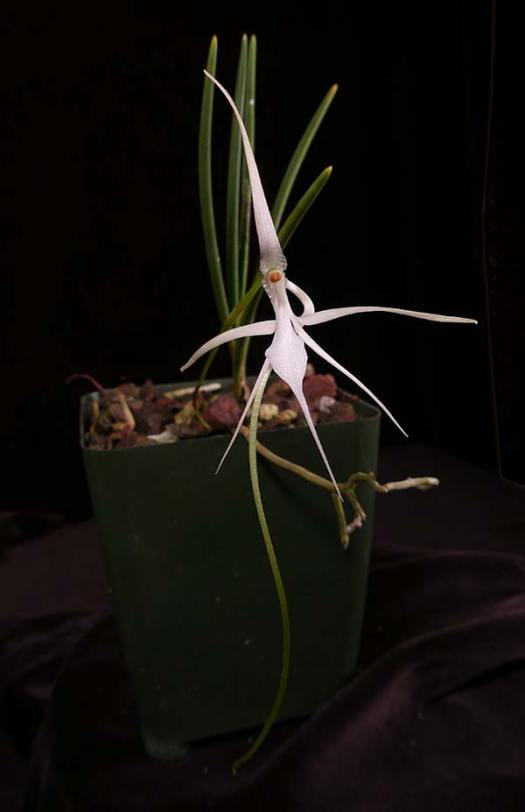
Jumellea teretifoliaAnother cool growing Madagascan species. The flower is bigge than the terete leaves. |
.jpg)
Oncidium harrisonianumFrom southeastern Brazil at elevations around 1000 m. This plant is bulletproof. I have had it for 15 years, made plenty of rookie mistakes with it, and it puts on a great display every year. It is mounted with no moss, so apparently needs to dry quickly. |
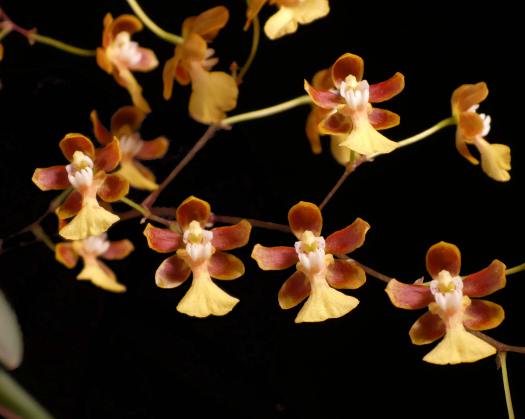 |
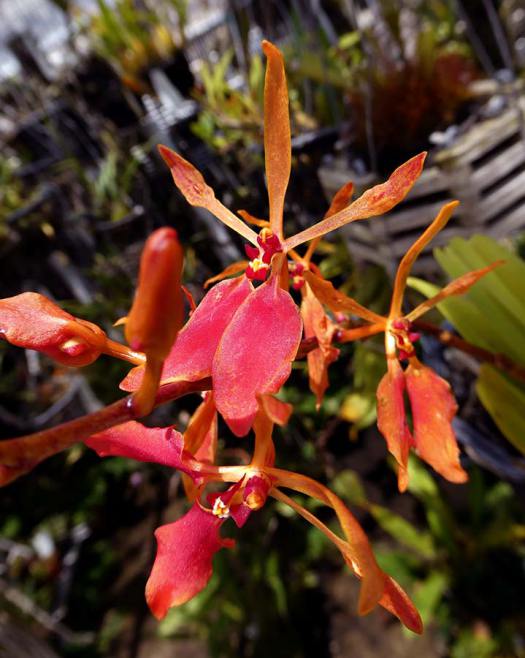 |
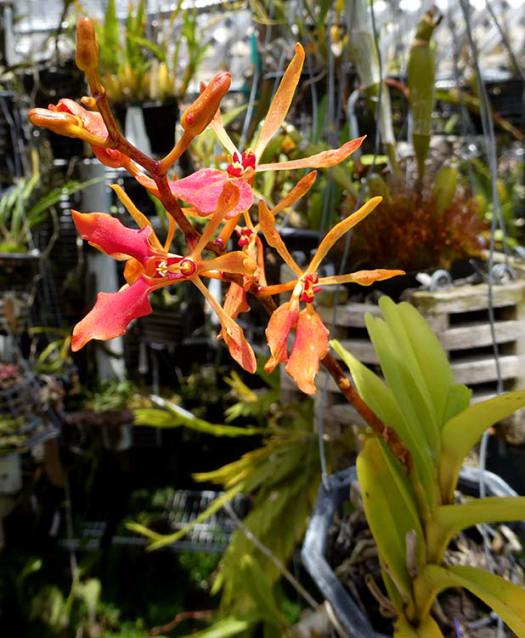 |
Renanthera pulchellaBright flowers on a 6-inch plant. I can't find out much information about it. IOSPE lists it as a hot-growing epiphyte from Myanmar with no elevation data. But clearly it is cold-tolerant since it lives and thrives on my patio. |
|

Rhymes with orange...I couldn't resist this one... I looked out my kitchen door and saw these in bloom together... left to right - Sobralia crocea, Bulbophyllum thaiorum, Dendrobium unicum. |
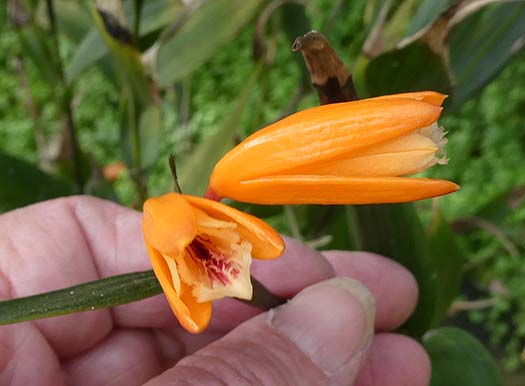
Sobralia croceaSmall, so here is a closer view. This is as open as the flowers get.Like the rest of the genus, they don't last long but bloom sequentially from an inflorescence. |
In the greenhouse... |
|
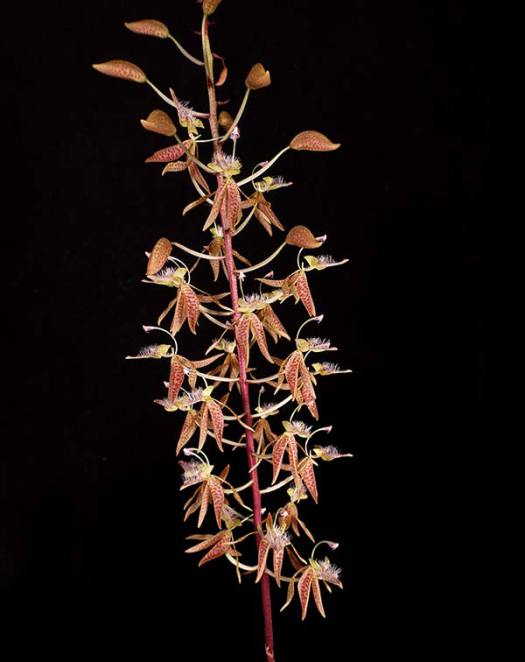 |
|
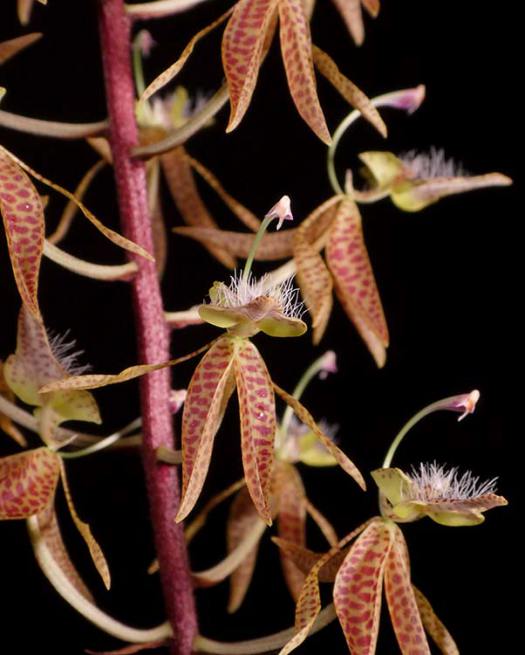 |
|
Polycycnis annectansI find these flowers absolutely fascinating. Just before the pandemic lockdown, the San Diego Orchid Society Conservation Committee had been preparing for a sale, accumulating plants... and then, nothing. Members were given the opportunity to buy what they wanted, and I grabbed this one and also Polycycnis muscifera (which is in spike... maybe next month...) I was told that it had been growing outside, and the elevation data for Ecuador seemed to indicate that it should be cold-tolerant. At the time that I got both plants, they were leafless, and even through the summer grew their single leaf only very slowly. So as the weather cooled I moved them to the greenhouse and they took off. The leaf on this one is huge relative to the plant. I must conclude then, that both species can survive on the cool side, but need to move into the intermediate range for good growth and blooming. |
|
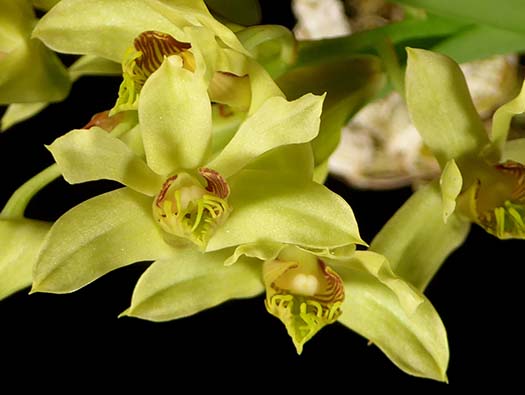 |
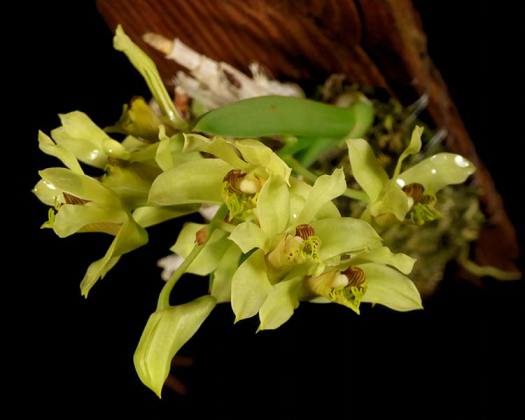 |
Dendrobium venustumA deciduous Dendrobium from Thailand, Laos, Myanmar, and Cambodia at moderate elevations. The lip is particularly interesting.
|
|
